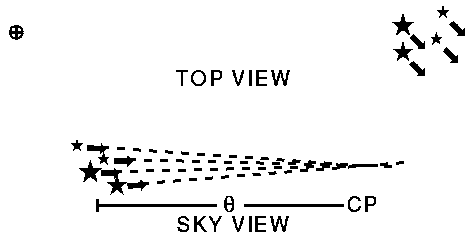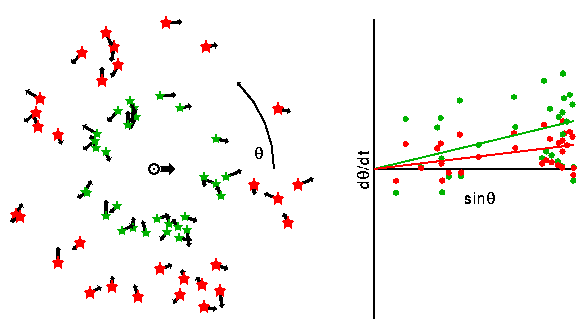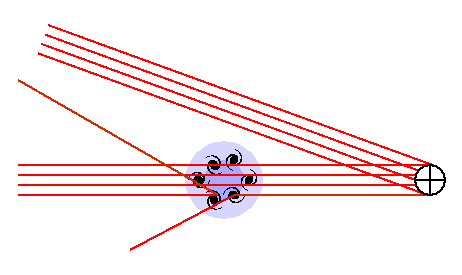
Почти невозможно ничего сказать о расстояниях до космических объектов. Почти, да не совсем, и астрономы разработали множество методов измерений расстояния. Здесь я опишу 26 из них. Я буду игнорировать работу, которая была проведена для определения астрономической единицы: мастштабного коэффициента для Солнечной системы, и только рассмотрим расстояния за нею.
Этот метод помечен как A так как он является золотым стандартом
для астрономических расстояний. Он основан на измерении двух углов
и прилегающей стороны триугольника образуемого звездой, Землей на одной
стороне орбиты и Землей шесть месяцев спустя на другой стороне орбиты.

Параллакс звезды есть половина угла на звезду на этой диаграмме. Таким образом параллакс есть угол на звезду в триугольнике Земля-Солнце-звезда. Поскольку этот угол очень мал, синус и тангенс параллакса хорошо апроксимируются самим углом, измеренным в радианах. Следовательно расстояние на звезду
D[в см] = [Расстояние Земля-Солнце в см]/[параллакс в радианах]Астрономы обычно называют Расстояние Земля-Солнце солнечной единицей 1 СЕ = 1.5E13 (15,000,000,000,000) см и измеряют малые углы в угловых секундах. Один радиан имеет 648000/Пи угловых секунд. Если мы используем эти единицы единица расстояния есть [648000/Пи] ае = 3.085678E18 см = 1 парсек. Звезда с параллаксом 1'' находится на расстоянии 1 парсек. Известные звезды не имеют столь большие параллаксы. Проксима Центавра имеет параллакc 0.76''.
Первый звездный параллакс звезды 61 Лебедя (61 Cigni) был измерен Фредериком Вильгельмом Бесселем (1784-1846) в 1838. Бессель известен также по функциям Бесселя в математической физике.
Не много звезд настолько близки, чтобы имеь значимые тригонометрические
параллаксы. Но когда звезды находятся в устойчивом звездном скоплении,
физический размер которого не меняется, как
Плеады,
то видимые движения звезд внутри скопления могут
быть использованы для определения расстояний до скопления.

D[в см] = VT[в см/с]/[d(theta)/dt]
D[в пк] = (VR/4.74 км/с)*tan(theta)/{d(theta)/dt[в ''/год]}
Необычная константа 4.74 км/с есть 1 ае/год.
Так как отрезок времени в 100 лет может быть использован для измерения
d(theta)/dt, точные расстояния до близких звезд возможны.
Этот метод применен к скоплению Гиады и дает расстояние 45.53 +/- 2.64 пк.
Среднее для измеренных Гипаркосом тригонометрических параллаксов
для членов скопления Гиады двет 46.34 +/- 0.27 пк
(Перриман и др.
).
Другой метод может быть использован для измерения среднего расстояния
до выборки звезд, если выбрать такие на почти одних и тех же расстояниях.

D[в см] = V(Солнце)[в см/с]/(mu [в радианах/с]) D[в пк] = 4.16/(mu [in ''/год])где константа 4.16 есть Движение Солнца в ае/год.
Когда у мвезд измерены радиальные скорости, то по рассеянию в их собственных движениях можно определить среднее расстояние. Это
(рассеяние в VR)[в см/с] D[in cm] = ---------------------------------------- (рассеяние в d(theta)/dt)[в радианах/с]
Закон дифференциального вращения в нашей Галактике может быть использован для определения расстояния до источника, есть его радиальная скорость известна.
Расстояние до расширяющегося объекта как остаток сверхновой, такой как Тихо можно измерить по:
Расстояние вычисляется тогда по формуле
D = VR/d(theta)/dt , где theta в радианахУ этого метода есть систематическая ошибка, тогда скорость вещества за ударным фронтом меньше чем скорость самого ударного фронта. В ОСН в адиабатической фазе это действительно имеет место, с VR = 0.75*V_sh, так что вычисленное расстояние на 25 % занижено.
Центр эллиптического кольца вокруг SN1987A в БМО по-видимому есть результат наклонного кругового кольца вокруг звезды-предшественника. Когда импульс УФ света от сверхновой ударяет в кольцо, оно загорается линиями в УФ, которые наблюдались International Ultraviolet Explorer (IUE). Это первое обнаружение этих линий в момент, t1, и также время когда эти линии пришли от последней части освещенного кольца, t2, были оба ясно видны в кривой блеска УФ-линий, полученной на IUE. Если t0 есть время, в которое впервые увидели СН, то добавочные времена на распространение света от передней и задней сторон кольца равны:
t1 - t0 = R(1 - sin(i))/c t2 - t0 = R(1 + sin(i))/cгде R есть радиус кольца в см. Итак
R = c(t1-t0 + t2-t0)/2Когда телескоп HST был запущен на нем была получена картинка СН 1987A и было видно кольцо, и был измерен theta -- его угловой радиус. Это сотношение дает расстояние:
D = R/theta theta в радианахПрименяя SN 1987A для БМО, получим D = 47 +/- 1 кпк (Gould 1995, ApJ, 452, 189). Этот метод тождествен методу расширения, в приложении к расширению оболочки излучения сверхновой, которое распространяется со скоростью света. Это может применить к другим известным геометриям также.
Если орбита двойной системы наблюдается и визуально и спектроскопически, то и угловой размер и физический размер орбиты известны. Их отношение дает расстояние.

Этот метод применяется для пульсирующих звезд. Используя кривые блеска и цвета, находят отношение радиусов на различных временах:
sqrt[Flux(t2)/SB(Color(t2)]
R(t2)/R(t1) = ---------------------------
sqrt[Flux(t1)/SB(Color(t1)]
Then spectra of the star throughout its pulsation period are used
Затем спектры звезд по из периоду пульсаций использованы для
нахождения их радиальной скорости Vr(t).
Knowing how fast the
star's surface is moving, one finds
R(t2)-R(t1) by adding up velocity*time during the time interval
between t1 and t2. If you know both the ratio of the radii
R(t2)/R(t1) from fluxes and colors and the difference in the
radii R(t2)-R(t1) from spectroscopy, then you have two
equations in two unknowns and it is easy to solve for the radii.
With the radius and angle, the distance is found
using D = R/theta.
In a double-lined spectroscopic binary, the projected size of the orbit a*sin(i) is found from the radial velocity amplitude and the period. In an eclipsing binary, the relative radii of the stars R1/a and R2/a and the inclination of the orbit i are found by analyzing the shapes of the eclipse light curves. Using the observed fluxes and colors to get surface brightnesses, the angular radii of the stars can be estimated. R1 is found from i, a*sin(i) and R1/a; and with theta1 the distance can be found.
The Baade-Wesselink method can be applied to an expanding star: the variations in radius do not have to be periodic. It has been applied to Type II supernovae, which are massive stars with a hydrogen rich envelope that explode when their cores collapse to from neutron stars. It can also be applied to Type Ia supernovae, but these objects have no hydrogen lines in their spectra. Since the surface brightness vs color law is calibrated using normal, hydrogen-rich stars, the EPM is normally used on hydrogen-rich supernovae, which are Type II. The Type II SN1987A in the Large Magellanic Cloud has been used to calibrate this distance indicator.
D = sqrt[L/(4*pi*F)]
When distances to nearby stars were found using trigonometric parallaxes in the late 19th and early 20th century, it became possible to study the luminosities of stars. Einar Hertzsprung and Henry Norris Russell both plotted stars on a chart of luminosity and temperature. Most stars fall on a single track, known as the Main Sequence, in this diagram, which is now known as the H-R diagram after Hertzsprung and Russell. Often the absolute magnitude is used instead of the luminosity, and the spectral type or color is used instead of the temperature.
When looking at a cluster of stars, the apparent magnitudes and colors of the stars form a track that is parallel to the Main Sequence, and by correctly choosing the distance, the apparent magnitudes convert to absolute magnitudes that fall on the standard Main Sequence.
When the spectrum of a star is observed carefully, it is possible to determine two parameters of the star as well as the chemical abundances in the star's atmosphere. The first of these two parameters is the surface temperature of the star, which determines the spectral type in the range OBAFGKM from hottest to coolest. The hot O stars show ionized helium lines, the B stars show neutral helium lines, the A stars have strong hydrogen lines, the F and G stars have various metal lines, and the coolest K and M stars have molecular bands. The spectral classes are further subdivided with a digit, so the Sun is a G2 star.
The second parameter that can be determined is the surface gravity of
the star. The higher the surface gravity, the higher the pressure in
the atmosphere, and high pressure leads to line broadening and also
reduces the amount of ionization in the atmosphere.
The surface gravity is denoted by the
L = 4*pi*sigma*T4*R2
L = A*Mb Mass-luminosity law with b = 3-4
g = G*M/R2
Given the temperature from the spectral type, and the surface gravity
from the luminosity class, these equations can be used to find the
mass and luminosity. If the luminosity and flux are known the distance
follows from the inverse square law.
One warning about this method: it only works for normal stars, and any given single object might not be normal. Main sequence fitting in a cluster is much more reliable since with a large number of stars it is easy to find the normal ones.
Cepheid variable stars are pulsating stars, named after the brightest
member of the class, Delta Cephei. These stars pulsate because the
hydrogen and helium ionization zones are close to the surface of the
star. This more or less fixes the temperature of the variable star,
and produces an instability strip in the H-R diagram.

L = Const * V(rot)4Since the rotational velocity of a spiral galaxy can be measured using an optical spectrograph or radio telescopes, the luminosity can be determined. Combined with the measured flux, this luminosity gives the distance. The diagram below shows two galaxies: a giant spiral and a dwarf spiral, but the small galaxy is closer to the Earth so they both cover the same angle on the sky and have the same apparent brightness.

L = Const * sigma(v)4Since the velocity dispersion of an elliptical galaxy can be measured using an optical spectrograph, the luminosity can be determined. Combined with the measured flux, this luminosity gives the distance.
When a quasar is viewed through a
gravitational
lens, multiple images are seen, as shown in diagram below.

Hot gas in clusters of galaxies distorts the spectrum of the cosmic
microwave background observed through the cluster.
The diagram below shows a sketch of this process. The hot electrons
in the cluster of galaxies scatter a small fraction of the cosmic
microwave background photons and replace them with slightly higher
energy photons.

The X-ray emission, IX, from the hot gas in the cluster is proportional to (1) the square of the number density of electrons, (2) the thickness of the cluster along our line of sight, and (3) depends on the electron temperature and X-ray frequency. As a result, the ratio
y2/IX = CONST * (Thickness along LOS) * f(T)If we assume that the thickness along the LOS is the same as the diameter of the cluster, we can use the observed angular diameter to find the distance.
This technique is very difficult, and years of hard work by pioneers like Mark Birkinshaw yielded only a few distances, and values of Ho that tended to be on the low side. Recent work with close packed radio interferometers operating at 30 GHz has given precise measurements of the radio brightness decrement for 18 clusters, but only 3 of these have adequate X-ray data.
The Doppler shift gives the redshift of a distant object which is our best indicator of its distance, but we need to know the Hubble constant.
But wait, there's MORE! Pulsar dispersion measures and interstellar extinction increase with distance along a given line of sight and can be used to determine distances. The globular cluster luminosity function can be used to estimate the distance to a galaxy from the observed brightness of its globular clusters.
Наставления : Часть 1 | Часть 2 | Часть 3 | Часть 4 | Возраст | Расстояния | Библиография | Относительность
© 1996-1999 Edward L. Wright. Последняя правка 6-Окт-1999